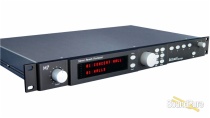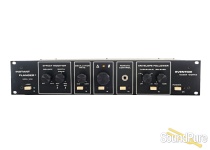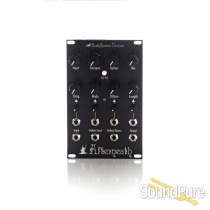-
Call Us Toll Free888-528-9703
-
Local/International (+1)919-682-5552
- Call Us! Toll Free! 888-528-9703
- Local / International (+1) 919-682-5552

Lexicon Prime Time Model 93 Vintage Digital Delay - Used From Lexicon
Vintage mono line digital delay from 1978 with expanded memory. In Used, Very Good condition
"Gone, Baby, Gone"
This one is sold. Don't miss the next one. Some things never even make it to the site so stay up to date on our used collection.
We get in many oddities, rare and vintage products, most of which go fast. If you're on the hunt for something specific, something unique, or something priced right, let us notify you on our used collection before the items even hit the site.
Want to know if one lands?
Notify MeWant to discuss what's coming?
Manufacturer's Description from Lexicon
The Lexicon Prime Time Model 93 is a digital delay rack effect unit released in 1978. It is capable of delivering completely unique and singular sounds.
The Prime Time 93 is a mono delay line with two inputs and two independent taps. You can invert either signal, mix their levels, and bypass the delay completely with the front panel switches.
There are a few special features that really make the Prime Time 93 a secret sonic weapon for people Daniel Lanois. Because of the technological limitations present in 1978, the Prime Time 93 (not to be confused with the subsequent “95” and “97” models) must reduce the bandwidth of any delay longer than 256ms; and that’s with the optional memory expansion installed.
From the owners manual:
“The indicated delay settings can be multiplied by factors of 2, 4, and 8 with the delay multiply switch to achieve delay times up to 128 msec X 8 = 1.024 seconds (or 256 msec x 8 = 2.048 seconds). The 1, 2, 4, and 8 positions also program the system bandwidth so that the 12 khz bandwidth (available at 1 x position) becomes 6khz at the 2 x position, 3khz at the 4 x position, and 1.5khz at the 8 x position.”
Basically, the longer the delay, the more lo-fi the output since you’re cutting out bandwidth. Just to give you an example, a telephone line operates at 3khz bandwidth. The same as when you’re using the 4 x delay multiply. Combine tone mangling delay with an oscillator and infinite repeat and you’re off to the races.
Lastly, there seems to be some confusion online about the Prime Time 93’s VCO. I heard it referred to as an LFO in one video and that didn’t sound right to me. I contacted Gary Hall, creator of the Lexicon PCM42 digital delay, who worked for Lexicon at the time the Prime Time 93 was in production. Here’s what Gary had to say:
“Actually, the Prime Time has both an LFO and a VCO. Internally, the digital circuits are all run by a clock at ultrasonic rates. In the fixed delay mode, the clock is a crystal oscillator. When you click the knob to ‘UnCal’, the clock is taken over by a Voltage-Controlled Oscillator running at similar high speed which you can change with the manual sweep or with the LFO.
The clock oscillator itself is a true VCO, however it’s not in audible range (I don’t have numbers in front of me, but it’s dog-whistle territory). It’s also linear-response only. No effort was made to have it conform to synth specs. So, VCO modulated by LFO and/or manual offset.”
About Manufacturer
With the introduction of the world's first digital processor in 1971, Lexicon became the world leader in digital audio. Since that time, Lexicon has continuously introduced ground-breaking technology to the audio industry. Today, Lexicon processing is heard on over 80% of all recordings, broadcast and film soundtracks and, in the home theater market, Lexicon sound is the acknowledged measure of excellence. In 2001, Lexicon proudly celebrated its 30th Anniversary. For thirty years, Lexicon has had a dramatic impact upon the professional audio industry (and over thirteen years in the consumer market).
Specifications
- *Dynamic Range: 95dB typical, 90dB Min 11A11 Weighted: 90dB typical, 86dB Min Unweighted
- **Total Distortion and Noise: Less than 0.08% at limit reference level and 1kHz; less than 0.3% at -34dB
- Frequency Response: 20Hz to 12kHz +1, -2dB, measured 12dB below limit level with Delay Multiply at Xl; bandpass is reduced to 6kHz, 3kHz, and 1 .5kHz with Delay Multiply at X2, X4, and X8 respectively.
- Delay capacity 128ms at full bandpass - standard; 256ms at full bandpass with optional add-on Delay Memory Module
- Delay Multiply Extends delays by X2, X4, or X8; (2048ms with addon Memory option)
- Delay Taps Two, individually selectable in 60 steps with digital display of each setting
- Delay Adjustment Continuous and noiseless adjustment from 100% to 50% of selected delay time; max. sweep range up to 1024ms
- VCO Modulation Depth adjustable from 0 to 100% of Delay Adjustment range; Frequency adjustable from 0.1 to 20Hz
- Delay Accuracy 0.01% long term in Cal mode plus .12ms delay offset
- Inputs Main and auxiliary inputs: balanced, 40k input impedance, 20dB gain switch allows matching of levels from -18dB to +18dB at limiting, XLR-3 type connectors.
- Master output Transformer isolated, balanced, 90 ohms max., adjustable to 18dBm max., XLR-3 type connectors
- Supplemental outputs Delay A, Delay B, and Input Mix, 100 ohms max, single ended, ~~~ phone jack connectors; A
- and B Outputs adjustable from +8to +18dBm
- Input Mixer 5 faders for Main Input, Auxiliary Input, Delay A and B recirculation, and Master; 5 level LED Headroom Indicator verifies proper mix level
- Recirculated Delay Rolloff Individual control for recirculated Delays A and B from 15kHz to 800Hz
- Output Mixer 5 faders for Dry Input, Aux Input, Delay A, Delay B and Master Out with overload indicator
- Repeat Hold Repeats signal in delay memory indefinitely without audio degradation, alternate action with LED indicator
- Delay Bypass Bypasses or cuts in delay system; when bypassed connects Input Mix to Master Output; switch actuated with LED indicator
- Remote Control Capability 1/4" phone jacks on rear panel for Repeat Hold foot switch, Delay Bypass foot switch, and Delay Adjust foot pedal pot or 0-10 volt signal
- Phase Inversion 3 switches allow Input, Delay A and/or Delay£ to be inverted
- Pre-emphasis/De-emphasis 75/15 ~s; max boost 12dB at 12kHz
- Size Standard 1911 rack mount, 3 1/211 high x 11 1/211 deep (483 x 89 x 292 mm)
- Weight 11 lbs. (5 kg); 15 lbs. shipping
- Power ll5/230V +10%, switch selectable, (l00/200V available as option) 50/60Hz, 35 watts max; standard IEC 3 wire power connector and cord
- Protection Mains fused, secondary supplies; fused with over voltage crowbar and/or current limited with thermal protection
- Connector Option Substitution of tip-ring-sleeve ~~~ phone jacks for all XLR-3 type connectors













